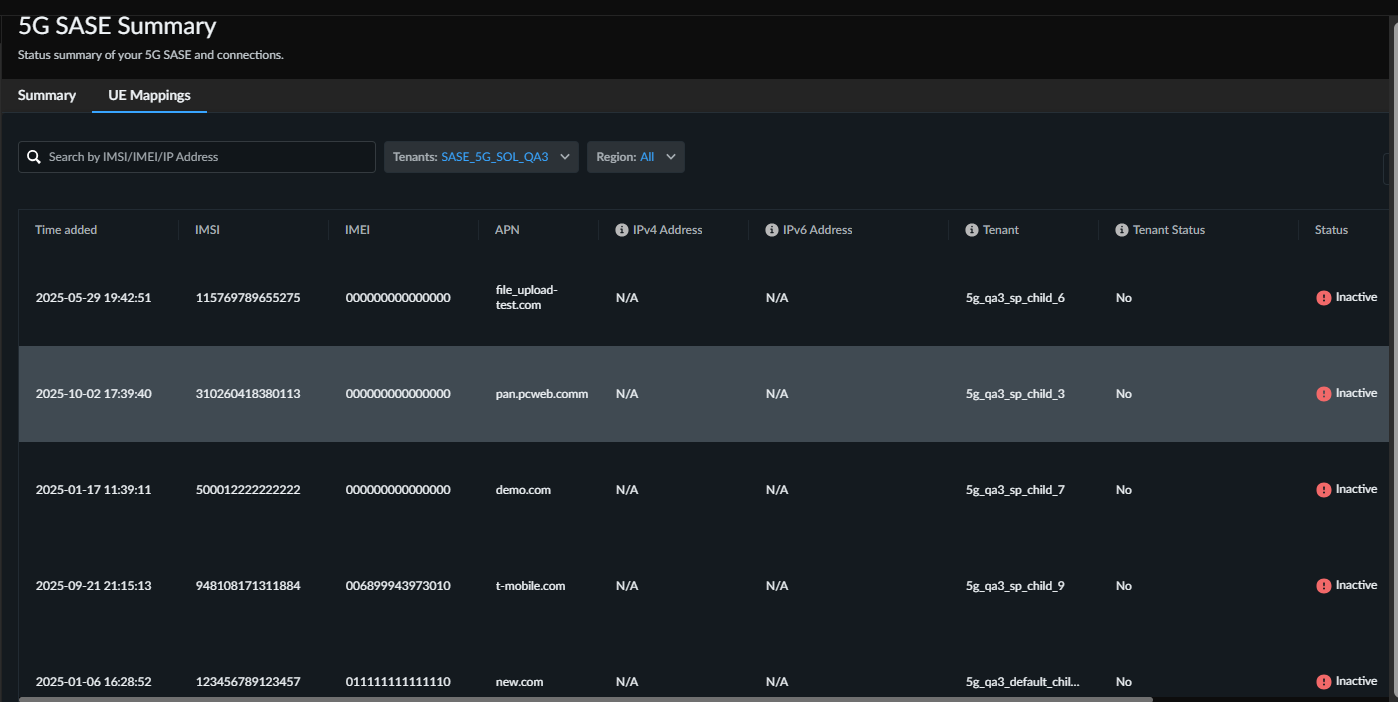Monitor Prisma SASE 5G
Table of Contents
Expand all | Collapse all
- Strata Multitenant Cloud Manager
- First Time Setup
-
- Monitor Status of Services through the ASC Support View
- Monitor Performance of Tunnel Status through the ASC Support View
- Monitor Performance of Auto Scaling through the ASC Support View
- Monitor Performance of Throughput through the ASC Support View
- Monitor Performance of the System through the ASC Support View
- View Licenses through the ASC Partner Portal
- View Status of Upgrades through the ASC Support View
- Manage Multitenant Reports
Monitor Prisma SASE 5G
Contains info about what details are available to monitor Prisma SASE 5G
| Where Can I Use This? | What Do I Need? |
|---|---|
|
|
The 5G SASE Insights provides comprehensive visibility into the performance,
health, and activity of 5G-enabled Secure Access Service Edge (SASE) environments. It
helps service providers and administrators track user connectivity, analyze traffic
trends, and ensure that network and security policies are operating as intended across
distributed 5G infrastructures.
To access this page, navigate to Insights 5G Summary.
The 5G SASE Summary page contains the following tabs:
- Summary
- UE Mapping
By combining performance metrics with control-plane and user-level insights, the 5G SASE
Monitoring feature enables proactive issue detection, faster troubleshooting, and more
informed capacity and security management decisions.
Summary
Summary pageoffers a high-level overview of network throughput, control plane health,
user equipment (UE) activity, and security incidents. This view enables quick
assessment of network performance, resource utilization, and service stability.

The summary page contains the following widgets whose data could be
interpreted as follows:
| Widget | Description | Benefit/Advantage |
| Throughput Trend | A time-series chart showing the rate of data passing through the SASE gateway (e.g., in Mbps or Gbps). | Performance & Capacity Planning: Track network load, identify peak usage hours, and proactively scale resources before congestion occurs. |
| UE Mapping (Counts) | A numerical summary showing the current counts of Configured, Registered, and Unknown User Equipment mappings. | Policy Health Check: Provides an immediate view of policy enforcement health and coverage, ensuring that most accessing devices are known and accounted for (Zero Trust). |
| Incidents by Severity | A visualization (e.g., a bar chart or donut chart) breaking down active security and network incidents by their classified severity level (e.g., Critical, High, Medium, Low). | Threat Prioritization: Enables security teams to instantly focus resources on the most critical threats, drastically improving the Mean Time To Respond (MTTR). |
| Radius Proxy Overview | A dashboard showing real-time statistics for the Radius control plane, including Total Proxies, Added/Cleared/Active Mappings, and control plane traffic counts. | Control Plane Health (RADIUS): Ensures the authentication and policy enforcement system is stable and processing mappings correctly, vital for service delivery. |
| UE Metrics | Charts tracking trends in User Equipment activity, such as UE registrations and de-registrations over time and by region. | Usage & Behavior Analysis: Monitors user adoption, device churn, and regional activity, aiding in resource allocation and early detection of widespread instability. |
UE Mapping
UE Mappingprovides detailed, per-device insights into User Equipment connections,
including identifiers (IMSI, IMEI), assigned IPs, access point names (APNs),
regions, and policy group mappings. The page includes global filtering options that
allow you to filter and view data based on tenants and
region, making it easier to isolate and analyze
information relevant to specific customer environments or geographic locations. This
granular visibility supports device-level troubleshooting, policy verification, and
multi-tenant management.

The UE mapping table contains the following details:
| Field | Description |
| IMSI | The International Mobile Subscriber Identity; the unique identifier for the user's SIM card. |
| IMEI | The International Mobile Equipment Identity; the unique identifier for the mobile device hardware itself. |
| APN | The Access Point Name; the gateway and settings used by the UE to connect to the SASE network. |
| IP V4 address | The current IPv4 address assigned to the User Equipment by the network. |
| IPv6 | The current IPv6 address assigned to the User Equipment by the network. |
| Tenant and its Status | The name of the organization/customer the UE belongs to, alongside their service status (e.g., active/inactive). |
| Region | The geographical SASE Point of Presence (PoP) or compute region that received the user's initial registration. |
| Groups | The list of security and policy groups the User Equipment has been assigned (e.g., "High-Risk-User," "Engineers," "Guest-Access"). |
